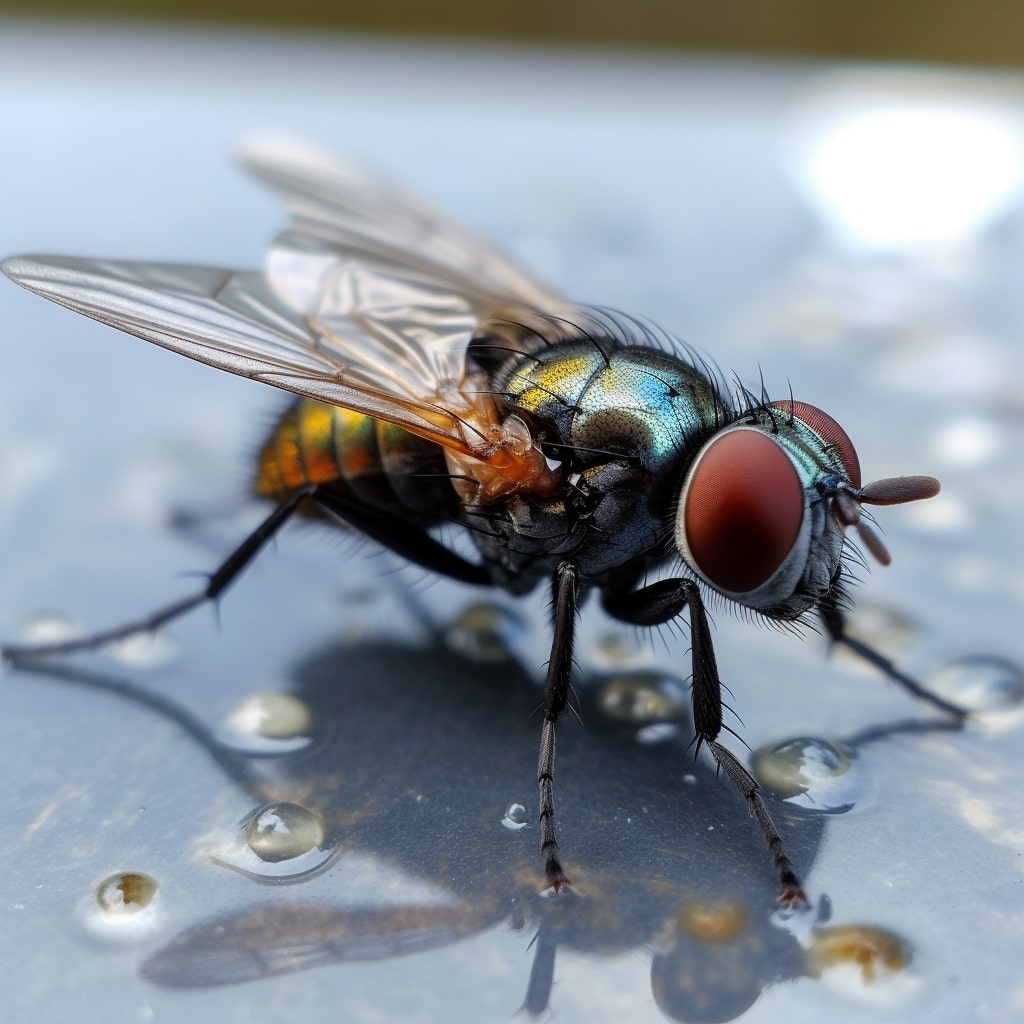The process of human decomposition and the subsequent attraction of flies to decaying bodies are crucial factors in the post-death cleanup process. Understanding the stages of decomposition and the factors that contribute to fly infestations is essential for effective remediation.
Flies are particularly drawn to decaying flesh during the second stage of decomposition when the body begins to bloat. Additionally, flies have a remarkable ability to locate dead animals through their keen sense of smell.
This article explores the significance of fly infestations and offers insights into their life cycle and detection mechanisms, to improve post-death cleanup efforts.
The Role of Flies in Post-Death Cleanup
Flies play a crucial role in the post-death cleanup process by aiding in the decomposition of the body through the laying of eggs and consumption of decaying flesh. Their behavior consists of scavenging for food and breeding, attracted by environmental factors such as odor and temperature.
However, fly infestations after death can pose serious health risks to the public. Strategies for preventing these infestations include promptly removing the body and hiring professional cleaners who specialize in post-death fly cleanup.
Factors That Attract Flies to Decomposing Bodies
During the process of decomposition, various factors within the environment surrounding a decomposing body attract flies. Fly behavior is influenced by the decomposition process and the odor-detection capabilities of these insects.
Flies are attracted to the odor of decaying flesh, which they can detect even in minute traces in the air. This insect attraction to the decomposition odor plays a significant role in post-mortem cleanup, as it necessitates thorough removal of the decomposing body and proper sanitation measures to prevent infestation.
Understanding the Infestation Process After Death
The infestation process after death can be better understood by examining the behavior and life cycle of flies and maggots. Understanding infestation patterns is crucial for preventing fly infestations and managing fly populations.
Fly infestations can have a significant impact on health, as flies are carriers of disease-causing pathogens. Effective post-death cleanup methods are essential to remove all traces of decomposition and eliminate potential breeding grounds for flies.
Exploring the Life Cycle of Flies about Decomposition
Throughout the process of decomposition, the life cycle of flies is intricately intertwined with the stages of decay and the subsequent attraction of these insects to the decaying matter. Understanding the life cycle of flies is crucial in managing and preventing fly infestations during post-death cleanup.
Key aspects to consider include fly behavior, such as their feeding and reproduction habits, the impact of temperature on fly infestations, and the importance of proper body disposal and cleaning hidden areas to prevent fly infestations.
Professional cleaners play a vital role in effectively managing post-death cleanup and preventing fly infestations.
Detecting Flies: How They Locate and Respond to Dead Bodies
Fly detection is a crucial aspect of understanding how these insects locate and respond to dead bodies. Flies track their movements by sensing the decomposition odor, which is the key attractant. They can detect minute traces of this odor in the air, allowing them to locate a dead body.
To prevent infestations, effective fly control methods should be employed. Additionally, fly larvae play a vital role in the decomposition process, feeding on fluids from the deceased.
The Significance of Fly Infestations in Post-Death Cleanup
During post-death cleanup, understanding the significance of fly infestations is crucial for effective removal and sanitation. Here are three key points to consider:
- Fly behavior: Flies are attracted to decomposing bodies due to the odor of decaying flesh. They locate dead animals through their keen sense of smell and lay eggs, leading to a rapid infestation.
- Health hazards: Fly infestations after death pose potential risks. Flies can carry and spread disease-causing bacteria and pathogens, increasing the risk of contamination and infection.
- Effective removal: Strategies for eliminating flies during post-death cleanup involve thorough cleaning, disinfection, and the use of insecticides. Prompt removal of the infested materials is essential to prevent further breeding and infestation.
Understanding the significance of fly infestations allows for the implementation of preventive measures to reduce the likelihood of infestations in the aftermath of a death, and helps professionals address the emotional distress caused by the presence of flies during the cleanup process.
Hidden Dangers: Flies in Household Crevices and Under Floorboards
Many flies can be found nesting in household crevices and under floorboards, posing hidden dangers during post-death cleanup. Preventive measures such as sealing household crevices can help minimize fly infestations.
Insecticides can be effective in controlling fly populations. However, it is crucial to ensure thorough removal through professional cleanup to eliminate any remaining flies and larvae.
Health risks associated with flies include the transmission of diseases. Dealing with fly infestations can also have a psychological impact on individuals.
Taking Action: The Importance of Thorough Post-Death Cleanup
Ensuring thorough post-death cleanup is essential for effectively addressing the aftermath of a deceased individual, minimizing health risks, and restoring a safe and hygienic environment.
To achieve this, it is crucial to employ effective cleanup methods, such as removing all traces of bodily fluids and tissues.
Additionally, preventing future infestations requires eliminating odor sources that attract flies and other insects.
Professional cleanup services should be considered to ensure thorough and proper disposal of contaminated materials, thus minimizing the risk of further contamination.
Conclusion
In conclusion, understanding the stages of decomposition and the factors that attract flies to decaying bodies is crucial for effective post-death cleanup.
Flies, particularly in warmer climates, have a keen sense of smell and can locate dead animals easily.
Their infestation can persist even after thorough cleaning, as larvae may continue to hatch.
By comprehending the life cycle of flies and their detection mechanisms, post-death cleanup efforts can be approached with greater efficiency and attention to detail to mitigate the risks of fly infestations.

